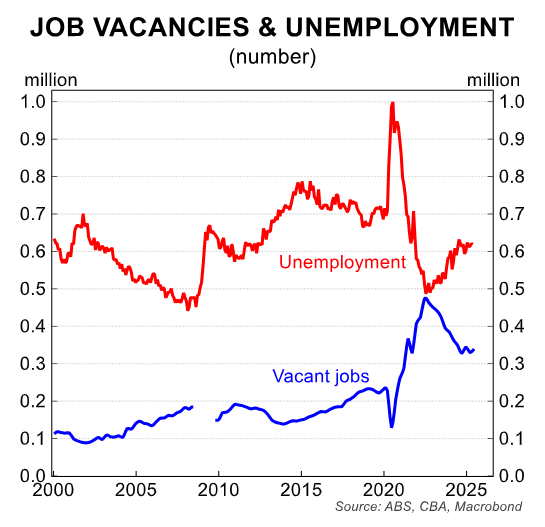By Lucinda Jerogin, Associate Economist at CBA
- Australian CPI inflation surprised to the downside at 2.1%/yr in May 2025. The policy relevant trimmed mean measure eased to 2.4%/yr. As a result,we brought forward our expected timing of the next RBA rate cut to July.
- News offshore was dominated by geopolitical events as hostilities between Israel and Iran escalated and subsequently cooled, to ultimately result in an agreed ceasefire.
- The week ahead will see the release of retail trade data and the Monthly Household Spending Indictor for May. International trade in goods, home pricesand building approvals are also due.
- Abroad, markets will continue to focus on geopolitics and news of US trade policy as the 9 July deadline approaches.
Domestically, all eyes were on the May monthly CPI release on Wednesday. Annual headline inflation eased to 2.1%/yr in May from 2.4%/yr in April. This was below our estimate and the market consensus of 2.3%/yr.
The headline monthly CPI can be somewhat misleading month to month, but when combined with the data ‘under the hood’, suggests inflation is likely to remain benign in Q2 25.
The two upside risks we had flagged; new dwelling costs and market services inflation, moderated in the month, contributing to the undershoot.
Benign inflation coupled with a steady labour market and a dovish May RBA decision has prompted us to tweak our base case to an RBA rate cut in July. We now expect the RBA to cut the cash rate by 25bp in both July and August, which would leave the cash rate at 3.35%.
The risk sits with a further rate cut later in 2025 or early 2026, depending on the transition of growth from the public to private sector and the possibility that this could see inflation undershoot the midpoint.
In addition to the CPI, job vacancies data was published later this week. Total vacancies rose by 2.9% to 339,400 in the three months to May 2025 following a 4.5%/qtr decline in February.
Vacancies remain well above pre pandemic levels, however, there are growing signs the labour market is loosening as the spread between the number of unemployed (618k) and the number of vacant jobs (339k) widens.

It was also a big week for State Budgets with the release of the NSW, Qld and ACT Budgets on Tuesday. Budget forecasts point to deficits in 2025-26 of $3.4bn, $8.6bn and $424.9m in NSW, Qld and the ACT, respectively.
Over the forward estimates, fiscal consolidation in NSW and the ACT will support operating balances into surplus while Qld remains in deficit. A key theme to flag is the sizeable downgrades in population forecasts across states in coming years.
A quicker than expected normalisation in Australia’s population growth poses downside risks to an already muddy economic outlook. Weaker population growth may limit a slow domestic consumption recovery and amplify constraints in the labour market. Another interesting dynamic to watch will be in Queensland as they balance the costs of the energy transition and the 2032 Olympics.
Turning our attention to the week ahead, local analysts will be focused on retail trade data and the Monthly Household Spending Indicator to gauge the progress of the household consumption recovery.
The flow of consumer spending data has remained soft to date in 2025. However, the interest rate cutting cycle should buoy consumption in the months ahead.
We anticipate retail trade and the MHSI rose by 0.5% in May. The goods trade balance will also be one to watch to see the continuing impact of uncertain US trade policy. We expect a further retracement in the trade balance in May to $5bn, driven by a pullback in commodity exports.
Home prices (CBA +0.6%/mth), building approvals (CBA +2.0%/mth) and private sector credit (CBA +0.6%/mth) are also due.
Offshore tensions in the Middle East dominated headlines this week after the US attacked three nuclear sites in Iran over the weekend sending jitters through financial markets. Iran responded with strikes on US assets in Qatar, but this was widely viewed as a face-saving exercise and by Tuesday President Trump had announced Israel and Iran had agreed on a ceasefire.
Financial markets recovered quickly, and attention shifted back to US trade policy. The NATO summit was held in the Hague on Tuesday-Wednesdaybringing together approximately 45 heads of state and governments. The focus was on defence. All NATO members signed onto President Trump’s demand of increasing defence spending to 5% of GDP, with the exception of Spain.
In the US this week, Fed Chair Powell reiterated last week’s post meeting message that the FOMC is in no hurry to cut the Funds rate. By weeks end, markets embraced the chance of earlier Fed rate cuts as President Trump suggested he could appoint a replacement for Powell as early as September.
Our international economics team continues to expect the Fed to next cut the Funds rate in October with follow up cuts in December and March.
Elsewhere, in Europe the news flow was quieter. One update to flag is the slight tweak our international economics team made to their ECB rates forecasts. Following the cautious comments from President Lagarde at the June post-meeting press conference, the team have pushed out the timing of expected ECB interest rate cuts. They now expect 25bp cuts in September and December, from previously July and September.
Offshore, focus in the week ahead will remain on geopolitics and news on US trade policy as the 9 July deadline approaches. US non-farm payrolls and Eurozone inflation data will also be watched. In Japan, signals from the Tankan survey on Tuesday will inform the BoJ’s decision making.
Across the Tasman, the Q1 25 Quarterly Survey of Business Opinion, filled jobs data and ANZ’s Business outlook will be released in New Zeeland.

